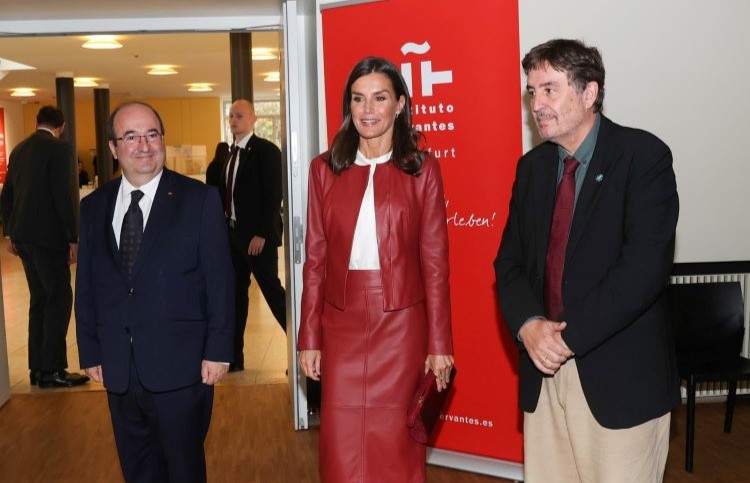The Diplomat
The King and Queen of Spain concluded their state visit to Germany yesterday with a ceremony in honor of German Hispanists at the headquarters of the Instituto Cervantes in Frankfurt.
The day began yesterday at the Frankfurt Book Fair, which was inaugurated the day before by the King and Queen of Spain and the President of Germany, Frank-Walter Steinmeier, and his wife, Elke Bündenbender, and in which Spain is the guest of honor. Since 1976, every year the Frankfurt Book Fair has had a Guest of Honor. Spain had the same privilege in 1991.
After being received by the Ministers of Culture of Germany, Claudia Roth, and Spain, Miquel Iceta, and the director of the Instituto Cervantes, Luis García Montero, among other personalities, Philip VI and Queen Letizia visited yesterday the Spanish exhibitors at the Fair and toured the exhibition The Prado in the streets, which consists of panels dedicated to the main masterpieces of the Prado National Museum, accompanied by the deputy director of the museum, Andrés Úbeda.
Later, the King and the First Vice President of the Government and Minister of Economic Affairs and Digital Transformation, Nadia Calviño, visited the European Central Bank (ECB), where they held a meeting with the president of the institution, Christine Lagarde.
After this visit, the King went to the Instituto Cervantes in Frankfurt to join the Queen at a round table in tribute to German Hispanism. Queen Letizia had previously arrived there, accompanied by Miquel Iceta, to chair the meeting, which was opened by Luis García Montero and moderated by Dieter Ingenschay, former president of the German Association of Hispanists and professor emeritus of Hispanic literatures at the Humboldt University of Berlin.
During the round table, García Montero affirmed that German Hispanists have contributed to the international dissemination of figures such as José Martí and Alejo Carpentier. For his part, Dieter Ingenschay (1948) expressed the gratitude of the hispanists for “the aid and solidarity support that Spain offers us” and highlighted the trajectory of the German Association of Hispanists (AAH), founded in 1973 and which today has 450 members. Five young Hispanists then proposed during the round table “widening the margins and changing the focus” of these studies, each from their respective disciplines: translation, didactics, linguistics and research.
The Instituto Cervantes, which was established in Germany in the early 1990s, has five centers in Germany: Berlin, Munich, Frankfurt, Hamburg and Bremen. More than 150,000 people living in Germany have learned or improved their Spanish after passing through its classrooms.
Around 800,000 people study Spanish in Germany. Spanish is the third foreign language in secondary education, with more than half a million students each year. At the university level, Spanish studies are in fourth place. In addition, there are 6.2 million potential users of Spanish in Germany, of whom some 400,000 (6 %) are native Spanish speakers. Of these, three quarters (about 300,000) are immigrants, mainly from Spain, Mexico and Colombia (2.5 % of all immigrants in Germany). The remaining 5.5 million users of Spanish have limited competence or study it in formal education or in other ways, according to data from the Cervantes Institute in February 2021.
At the end of this meeting, King Philip and Queen Letizia went to Frankfurt airport to return to Spain, thus concluding the state visit to the Federal Republic of Germany.






